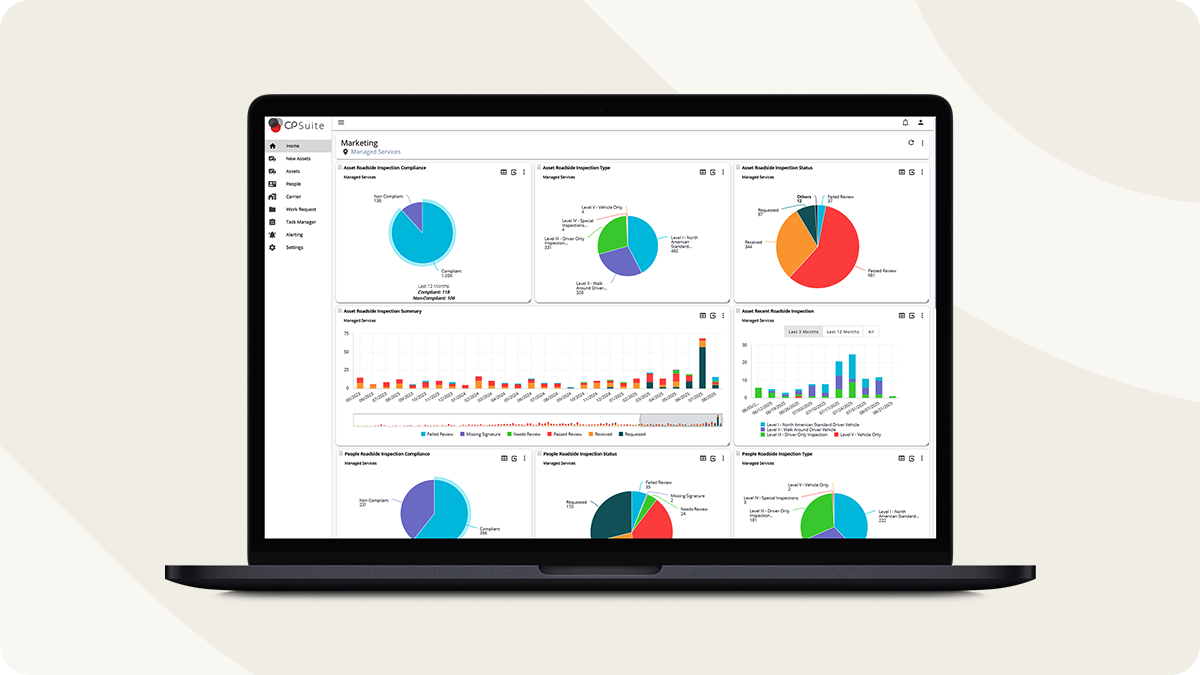One of the most critical tools the Department of Transportation (DOT) uses to uphold this standard is mandatory drug and alcohol testing. These testing requirements are designed to identify and prevent substance abuse among commercial motor vehicle (CMV) drivers, particularly those operating in safety-sensitive roles such as operating large trucks or buses.
The DOT drug testing program plays a central role in maintaining compliance with federal safety regulations, protecting lives, and promoting a culture of accountability within the transportation industry. All motor carriers, fleet operators, and commercial drivers subject to DOT regulations must comply with specific testing protocols, including pre-employment screening, random testing, post-accident testing, and more.
Understanding what the DOT drug test is looking for—and why it’s required—helps fleet managers and drivers stay compliant, avoid costly penalties, and maintain safe operating environments. In this article, we’ll break down what substances are tested, when tests are conducted, and why this process is so crucial for fleet safety.
Who is Subject to DOT Drug Testing?
DOT drug testing applies to individuals who perform safety-sensitive duties, including:
- Commercial driver’s license (CDL) holders operating commercial motor vehicles with a gross vehicle weight rating (GVWR) of 26,001 pounds or more.
- Drivers who transport hazardous materials that require placarding.
- Drivers who operate passenger vehicles designed to transport 16 or more passengers, including the driver.
- Mechanics, dispatchers, or others who perform safety-sensitive tasks as defined by specific DOT agencies (such as FMCSA, FAA, FRA, FTA, PHMSA, or USCG).
Anyone in a safety-sensitive role is legally obligated to comply with DOT drug and alcohol testing requirements.
Why Drug Test?
Safety Assurance – Reducing Risk of Impaired Driving Incidents
Drivers under the influence of drugs pose a significant threat to road safety. Impaired reaction time, poor decision-making, and lack of coordination can lead to devastating accidents—putting not only your driver at risk but also other motorists, pedestrians, and property. DOT drug testing acts as a preventive safety net, reducing the likelihood of substance-impaired drivers getting behind the wheel and safeguarding everyone on the road.
Protecting Company Reputation and Public Trust
In the transportation industry, reputation is everything. News of an accident involving a driver under the influence can quickly tarnish your brand, erode customer confidence, and affect your ability to secure contracts or retain business. A well-implemented drug testing program demonstrates a clear commitment to safety and professionalism, enhancing your fleet’s credibility and public image.
Preventive Culture and Proactive Driver Management
DOT drug testing fosters a culture of accountability and prevention. It sends a clear message to drivers and employees that safety is a priority—and that there are systems in place to maintain high standards. In addition, testing programs can help identify drivers who may need support or intervention, allowing fleet managers to address issues early through return-to-duty protocols, follow-up testing, or employee assistance programs (EAPs). By proactively managing risk, you’re not just meeting compliance standards—you’re actively shaping a safer, healthier workforce.
Regulatory Basis (FMCSA, 49 CFR Part 40)
The regulatory foundation for DOT drug testing is outlined in Title 49 of the Code of Federal Regulations (CFR), Part 40. This regulation details everything from specimen collection procedures to laboratory testing protocols, medical review processes, and how test results must be handled.
For fleet operators specifically regulated by the Federal Motor Carrier Safety Administration (FMCSA), these requirements are a central part of maintaining compliance. The regulations cover:
- The substances tested for
- Testing methods and procedures
- Roles of third-party administrators, medical review officers, and designated employer representatives (DERs)
- Employee education and awareness programs
Failure to adhere to these federal standards can result in significant penalties, loss of operating authority, and serious safety liabilities.
What Does DOT Drug Test For?
To ensure safety and prevent impaired driving, the Department of Transportation requires a specific set of substances to be tested through a standardized five-panel drug test. This testing panel is designed to detect commonly abused drugs that could impair a commercial driver’s ability to safely operate a vehicle.
Detailed Breakdown of the Five-Panel DOT Drug Test
The standard DOT drug test screens for the following five categories of drugs:
- Marijuana (THC)
- Despite changing laws around recreational and medical marijuana in many states, marijuana remains strictly prohibited under DOT regulations. Even legal use can result in disqualification from safety-sensitive duties if THC is detected in a drug test.
- Despite changing laws around recreational and medical marijuana in many states, marijuana remains strictly prohibited under DOT regulations. Even legal use can result in disqualification from safety-sensitive duties if THC is detected in a drug test.
- Cocaine
- A powerful stimulant that poses serious safety risks, cocaine use can impair judgment, reaction time, and physical coordination—all of which are critical for safe commercial driving.
- A powerful stimulant that poses serious safety risks, cocaine use can impair judgment, reaction time, and physical coordination—all of which are critical for safe commercial driving.
- Amphetamines (Including Methamphetamine)
- These include substances like Adderall and methamphetamine. While some prescription amphetamines may be permitted with a valid prescription, unauthorized use or abuse leads to disqualification.
- These include substances like Adderall and methamphetamine. While some prescription amphetamines may be permitted with a valid prescription, unauthorized use or abuse leads to disqualification.
- Opiates (Heroin, Codeine, Morphine)
- Opiates are powerful pain-relieving drugs that can cause sedation, slowed reaction times, and dependence. DOT testing targets both illicit and certain prescription opiates if abused.
- Opiates are powerful pain-relieving drugs that can cause sedation, slowed reaction times, and dependence. DOT testing targets both illicit and certain prescription opiates if abused.
- Phencyclidine (PCP)
- PCP is a dissociative drug known to cause hallucinations, confusion, and aggressive behavior—severely impairing a driver’s ability to function safely behind the wheel.
Expanded Substances: Semi-Synthetic Opioids
DOT regulations have expanded in recent years to include semi-synthetic opioids, which are frequently prescribed but also commonly misused. These include:
- Oxycodone (e.g., OxyContin, Percocet)
- Hydrocodone (e.g., Vicodin, Norco)
- Oxymorphone (e.g., Opana)
- Hydromorphone (e.g., Dilaudid)
These drugs are included due to their increasing involvement in drug-related crashes and fatalities. Even when legally prescribed, their use must be disclosed and medically approved under DOT standards.
Testing Methodologies
Currently, urine testing is the only approved and widely used method for DOT drug testing. Urine specimens are collected under controlled procedures to ensure accuracy and integrity.
However, the DOT has recently initiated oral fluid testing pilot programs, with proposed rule changes to incorporate oral fluid testing as an alternative method. This shift aims to reduce tampering, improve detection of recent drug use, and enhance overall testing reliability.
Both urine and oral fluid samples, once approved and in use, will be subject to strict laboratory testing and review by a Medical Review Officer to confirm results and ensure fairness.

Best Practices for Fleet Managers
To ensure long-term compliance and foster a proactive safety culture, fleet managers must go beyond simply conducting drug tests—they must build a comprehensive, well-documented, and well-communicated program that aligns with DOT standards and operational best practices.
Implementing a Strong Drug and Alcohol Testing Policy
A clear and compliant Drug and Alcohol Testing Policy is the foundation of any successful program. This policy should outline:
- Testing types and frequency (e.g., pre-employment, random, post-accident).
- Substances tested under DOT guidelines.
- Procedures for specimen collection and testing.
- Consequences for positive test results or refusal to test.
- Return-to-duty and follow-up testing processes.
The policy must be accessible to all employees, reviewed regularly, and updated to reflect the latest regulatory changes. It should also be included in driver onboarding and compliance training materials.
Educating Drivers on Substances Tested and Procedures
Driver education is critical to program success. Drivers should fully understand:
- What substances are tested for and why.
- The process for testing and their rights/responsibilities.
- The importance of compliance, including the risks of over-the-counter or prescribed medications that may trigger test results.
- What happens in the event of a positive result or test refusal.
Education should be ongoing, not just during onboarding. Conduct regular refresher training and provide updates when there are regulatory changes or trends (e.g., inclusion of new substances like synthetic opioids).
Partnering with Third-Party Administrators (TPAs) for Testing and Recordkeeping
Many fleets benefit from working with a Third-Party Administrator or Consortium/Third-Party Administrator (C/TPA) that specializes in DOT compliance. These partners:
- Manage random testing pools.
- Schedule and conduct tests through certified collection sites.
- Maintain records and chain-of-custody documentation.
- Provide access to Medical Review Officers (MROs).
- Ensure all testing procedures are compliant with 49 CFR Part 40 regulations.
A reliable TPA partner streamlines administration, reduces errors, and ensures your fleet is always audit-ready.
Keeping Documentation and Test Results Audit-Ready
Proper documentation is key to passing an FMCSA audit. Fleet managers must maintain:
- Records of all drug and alcohol test results.
- Documentation of testing policies and driver notifications.
- Random test pool selection records and test rosters.
- Return-to-duty and follow-up testing documentation.
- Training logs for supervisors and drivers.
These records should be securely stored, easily retrievable, and retained according to DOT retention timelines. Investing in a centralized compliance management system or digital document storage solution can significantly ease this process.
Consequences of Failing a DOT Drug Test
Failing a DOT drug test is a serious matter that carries immediate and long-term consequences for both drivers and fleet operations. The DOT enforces strict protocols to ensure that safety-sensitive roles are filled only by individuals who are drug- and alcohol-free. Understanding these repercussions is essential for proactive risk management and compliance planning.
Immediate Removal from Safety-Sensitive Functions
Upon receiving a verified positive drug test result, a driver must be immediately removed from all safety-sensitive duties. This includes operating a commercial motor vehicle, performing vehicle inspections, or any other role where safety is a concern. The driver cannot return to duty until they have successfully completed a Substance Abuse Professional (SAP) evaluation and all subsequent steps in the return-to-duty process.
This immediate removal can create operational disruptions, especially for smaller fleets with limited driver availability, and may result in service delays or unmet delivery schedules.
Return-to-Duty and Follow-Up Program Requirements
A failed DOT drug test initiates a structured Return-to-Duty (RTD) process, which is overseen by a qualified SAP. The steps include:
- An initial SAP assessment, where the driver’s situation is evaluated.
- Completion of SAP-recommended education or treatment programs.
- A return-to-duty drug test, which must produce a negative result before the driver is permitted to resume safety-sensitive tasks.
Once reinstated, the driver is subject to a rigorous follow-up testing schedule, typically consisting of at least six unannounced tests over 12 months, though it can extend up to five years. These tests are in addition to the regular random testing pool and are closely monitored by the SAP and employer.
Impact on Driver Employment and CSA Scores
Failing a DOT drug test can have long-term career consequences. Many motor carriers are hesitant to hire drivers with a failed drug test on record, especially if they have not completed the return-to-duty process. Some fleets may choose to terminate employment altogether, even if the driver completes the SAP process, due to internal company policies or insurance requirements.
Additionally, a failed drug test can indirectly impact a motor carrier’s Compliance, Safety, Accountability score. While individual test results are not directly included in CSA data, associated violations—such as operating a CMV after a failed test or not removing a driver from duty—can lead to citations that affect a fleet’s CSA profile, increasing the risk of audits, inspections, and regulatory scrutiny.
Strengthen your DOT Compliance and Protect your Fleet with Fleetworthy
Fleetworthy’s comprehensive Vehicle and Driver Safety and Compliance services provide expert oversight, digital tracking of vital documents, and proactive management of regulatory requirements, including DOT drug testing mandates.
Take control of your fleet’s safety culture today—contact Fleetworthy and ensure your operation remains compliant, secure, and audit-ready.




